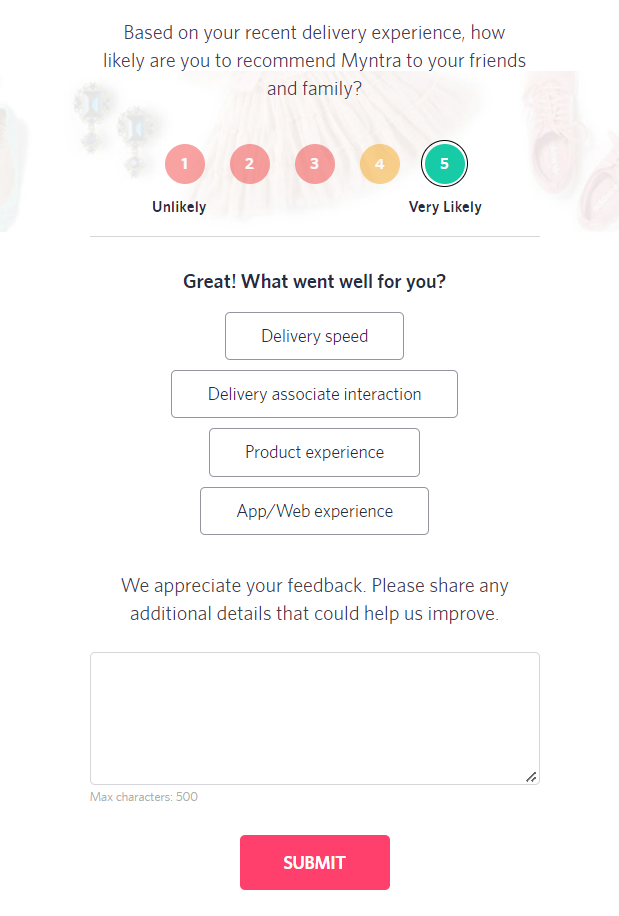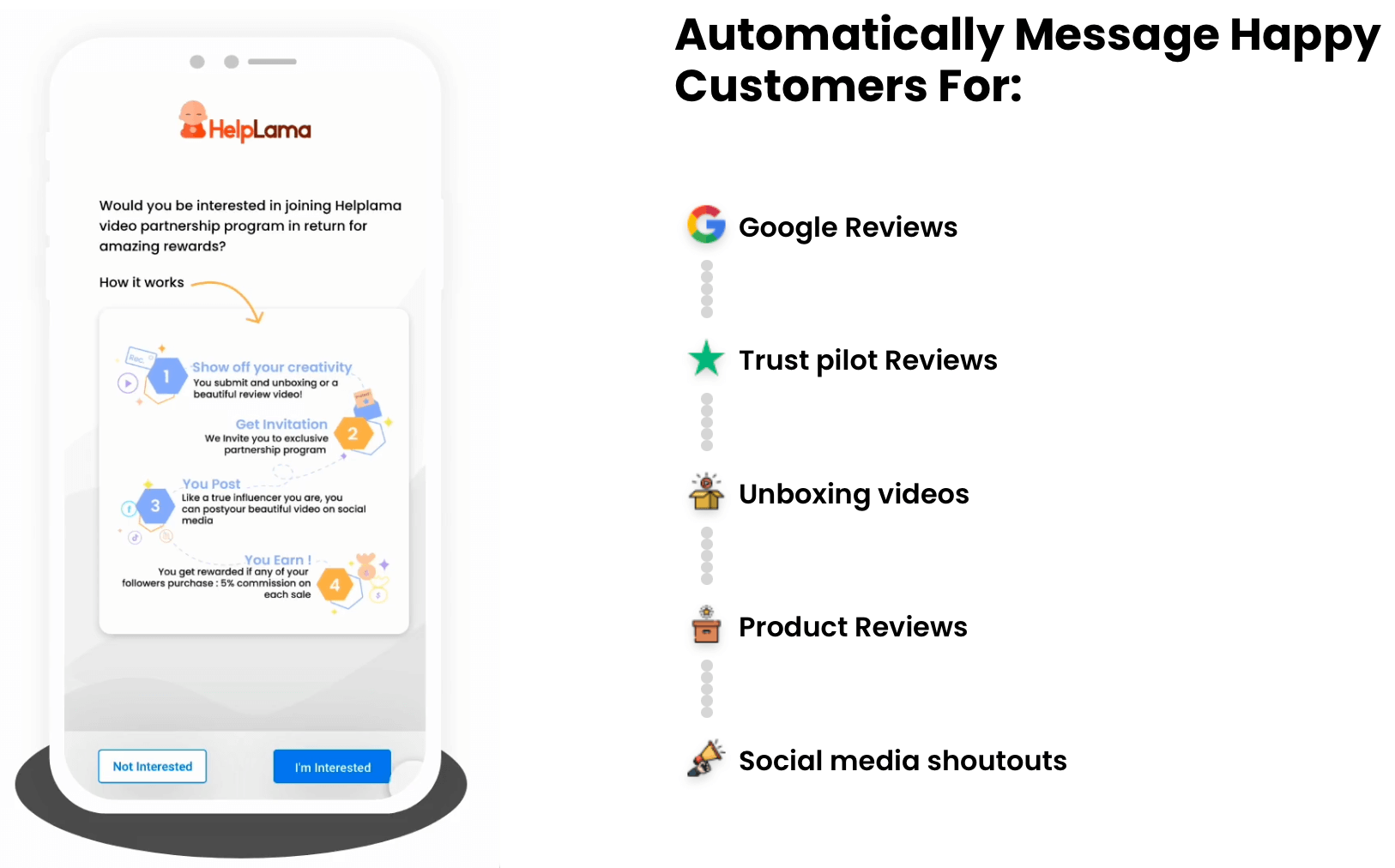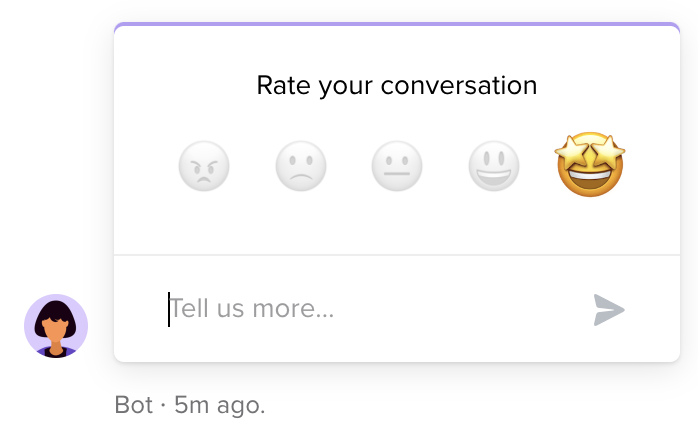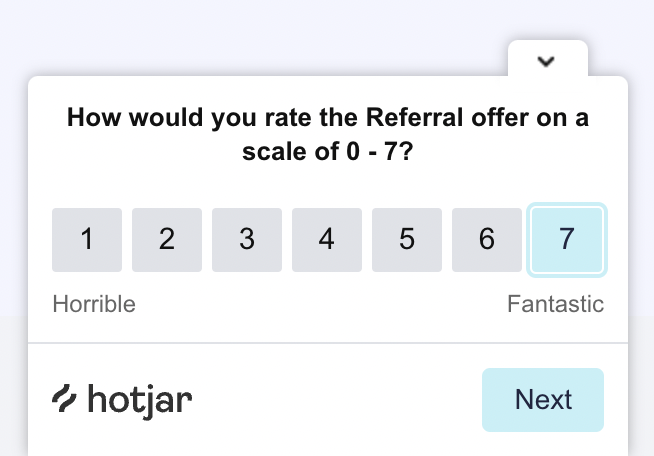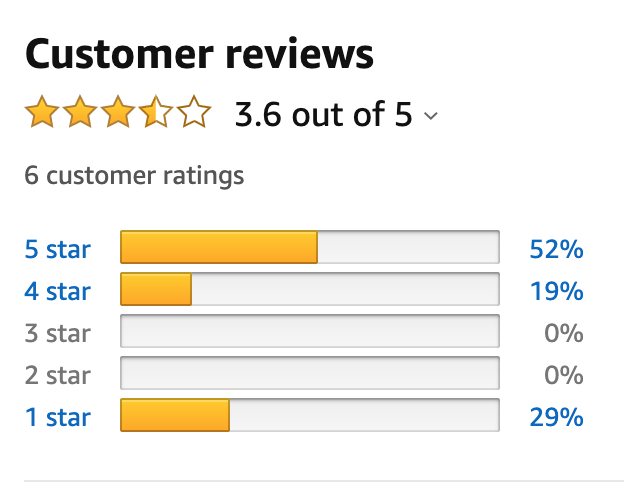Do you research online reviews before purchasing a new product or service?
I do. I am one of the 81% of shoppers who research online reviews before buying in-store. Not only this, additional studies have proved that consumers trust user reviews more than a brand’s sales pitch.
So, it’s a no-brainer that you should ask your customers to review your products and services and use those reviews and testimonials as social proof.
But how? In this course, we have included clever ways to ask for reviews examples and put together some effective strategies for collecting user reviews and testimonials that work!
Contents in this course are as follows:
– Introduction: Asking for customer reviews
– Lesson 1: When to ask for a review?
– When they’re satisfied
– How to know when they’re satisfied?
– Lesson 2: How to ask for a review?
– Email
– SMS
– Live Chat/Web Chat
– Popups
– Point of sale
– Lesson 3: Where to get good reviews?
– Google business profile
– Social media
– Industry-specific sites
– Product-specific sites
– Amazon reviews
– Your own website
– Bonus Lesson: How to get customers to submit reviews?
– Freebies/Coupons
– Automate the review collection
Introduction: Asking for customer reviews
You can ask your customers for reviews anytime anywhere, it just takes an email or message. But would they submit a review if you randomly ask for it? Most likely no.
Even after specialized marketing efforts, only 5-10 percent of consumers write reviews. However, these reviews bring a significant proportion – 20% of total sales.
So, if you want your customers to submit reviews or testimonials for your product, you must pitch them with a defined strategy.
You should know:
- When to ask for a review,
- How to ask for a review, and
- Where to get these reviews.
And this is exactly what this course is about. So, let’s get started with the first lesson.
Lesson 1: When to ask for a review?
The time and moment when you ask your customers for a review are important.
The best moment to ask your customers for a review is:
When they are satisfied!
A customer will most likely reply with a ‘yes’ when they are satisfied with the product or customer experience delivered by you!
Supposing that you run an e-commerce business, when do your customers feel satisfied? There can be many happy moments – when they successfully make a purchase, when a product is delivered early or on time, when they get a discount, etc.
You should consider all these interactions as opportunities to ask the customers – “Would you like to leave a review or testimonial?”
They’ll most likely reply with a ‘yes’ if they’re satisfied with your service or product. In short, the higher the customer satisfaction, the higher the chances of getting reviews!
But… how to know when they’re satisfied?
To identify the happy moments when your customers feel satisfied with your product or brand, you should:
- Analyze the customer journey
- Divide the customer journey into parts
- Identify customer actions during different parts of their journey
It can be any part of the customer journey where customers feel satisfied. As per the American Express study, 68% of customers said the customer service rep was key to a recent positive service experience.
So now you know when your customer feels satisfied but the way or tool you choose to ask for a review is also crucial. This is what lesson two is about.
Lesson 2: How to ask for a review?
The way you choose to ask your customers for reviews and how you use those ways are important. There are many ways you can use to approach users and ask for reviews including the major ones mentioned as follows:
1. Email
You might be wondering – Does email still work? Does anyone read email in 2022? Well, a big yes!
Moreover, email is part of consumers’ everyday lives.
In our email marketing survey, we discovered that email is part of everyday life for a large proportion – 72% of consumers!
So without further ado, let’s know how to ask customers for a review through email.
Supposing you’re in ecommerce, here’s an example:
So what happens here is:
- The merchant asks the consumer to rate the service from 1 to 5 when the product was delivered before the expected delivery date.
- When the consumer clicks on the rating bar, they get redirected to the brand’s review page where the consumer is asked to describe their experience as follows:
You can also redirect them to your Google Business Profile or any other review portal based on your niche. Great strategy, right?
And the consumer will most likely and happily submit the review because they got the delivery before the expected delivery date.
Tip (if you run a store): You can add 1-2 days extra to the estimated delivery date that you communicate to your customers so they receive the product early or at least on time as per the estimated date.
But creating these email templates will require an email marketing tool. There are many tools that you can use to create custom email templates.
Some best tools for email marketing:
– Helplama Helpdesk
Starts at $99/month/3 users (unlimited tickets/contacts) a 14-day free trial
You might be wondering – why am I suggesting help desk software for email marketing. Well, Helplama is not just a help desk. It comprises strong automated processes that can help you satisfy your customers and then collect reviews and UGC!
It’s possibly the ONLY helpdesk that converts customer service into a marketing pipeline.
– Mailchimp
Free plan; starts at $9.99/month
If you have used an email marketing tool, you might have heard of Mailchimp. It’s one of the most popular email marketing tools that also comes with a freemium version with a reach for up to 2000 contacts. It comprises all the basic features that email marketing tools usually provide – Scheduling campaigns, A/B testing, performance reports, etc.
Mailchimp is great if you are just starting out, but if have a big contact list, say more than 15k subscribers, it may seem pricey to you.
– ActiveCampaign
Starts at $9/month; a 14-day free trial
The best email marketing software when it comes to automation. You can set custom rules to automate the emails for different scenarios. ActiveCampaign also facilitates website messaging and Sales CRM. Moreover, you get over 850 integrations for a smooth omnichannel experience. But it doesn’t offer a free plan.
– HubSpot
Starts at $50/month; a 14-day free trial
Hubspot is one of a few marketing service providers that provide a complete marketing suite. Whether it is email, social, or website, HubSpot can help you create and manage campaigns on various channels. Moreover, with HubSpot CRM, you can attract an audience with lead forms, online ads, and live chat.
So these were some of the best tools that can help you with email marketing. The next best way to ask for reviews is…
2. SMS
Direct message – an old but gold marketing strategy that works like no other strategy or channel. As per studies, the average opening rate for SMS marketing is a whopping 98%! You can directly pitch your customers a to-the-point message, including a link that takes them to the review page.
Here’s an example of an e-commerce store:
We’ve delivered your product in advance. Hope your bag of joy brought a smile to your face. We’d love to hear about your experience: https://example.com
You would need a tool to automate these SMS. If you are not already using any tool to automate SMS, you can opt for Helplama Helpdesk, Twilio, or Mobile Monkey.
3. Web chat or Live chat
If your business’s website is a key source of leads, you should have a live chat widget in place. That’s because 77% of customers won’t make a purchase if there’s no live chat support. Moreover, live chat can be the way to ask your website audience for reviews.
Have a look at this great example:
- You assist or resolve a consumer’s issue through live chat
- Then you ask them to rate their experience:
- When consumer clicks on the rating, you ask them to describe their experience in a few words:
You can embed the customer review of a product on an e-commerce website or export them to review portals based on industry.
But… you will need live chat software for that. If you don’t have live chat software already, I will again recommend you the omnichannel tool – Helplama Helpdesk
Like live chat, the next way on how to ask clients for reviews is also exclusive to websites and apps:
4. Popups
Popups are another best and most targeted way of asking customers for reviews and testimonials that work like a charm. You can use popup in various sections of your websites in a targeted way.
Here’s an example of how it works:
- A website visitor joins your referral program
- A popup shows up asking them to rate their experience on a scale of 0-7:
- The visitor taps on 7 and then on the Next button:
- At last, they are asked to describe their views on the referral program.
This strategy can be used to ask website visitors at different points of their journey on your website, say when they create an account, buy a product, use a SaaS, etc.
The next way to ask for reviews is exclusive to brick-and-mortar stores.
5. Point of Sale
Do you run a brick-and-mortar store? Reviews are important for your local business as well. That’s because digital word of mouth has become a significant path in consumers’ buying journey even when they are buying in-store.
As I mentioned before – 81% of shoppers research online reviews before buying in-store. So, your physical store needs to have an online presence and reviews as social proof.
Unlike online stores, physical stores have the benefit of asking for reviews at the point of sale. Face-to-face interaction with customers increases the chances of getting reviews because it adds a personal and relational touch to the request.
So how to ask customer for review at the point of sale?
On successful competition of purchase, just ask them to leave a review without any hesitation – “Would you like to leave a review on our services” Or a demanding one – “If we were up to your expectations, would you like to leave a review?”
And if you have delivered good services, they are more likely to say “yes.” So these were some of the key ways on how to ask customers for reviews, putting an end to lesson 2.
The third lesson is more crucial because it comprises the digital places where you can gather or store the reviews!
Lesson 3: Where to get customer reviews?
This lesson will help you identify the websites, review portals, or online places where you should collect reviews from your customers.
Well, the review sites, directories, or places where you should get reviews, depends on the niche or industry you’re in. For example, if you run a local grocery store, Google Business Profile will be the primary site where you should get reviews from your store. That’s because most of your customers will be looking for you on Google to get your contact information or direction to reach your store.
On the other hand, if you are a SaaS provider, review sites like G2 and Capterra will be the primary sites to gather reviews. So, where you should get reviews depends on your niche and industry.
Nevertheless, I have put together some of the best sites and review portals where you should be getting reviews from your customers:
1. Google Business Profile (GBP)
Google Business Profile (or Google My Business) is a foundational channel where you should get reviews from your customers.
If you’re running a local business or professional, GBP is a key channel for you because most of your local customers would be searching Google for your contact info or direction to your physical location.
Asking for Google Reviews:
So, how to ask for a Google review for your business? You can add a link to your GBP in your email signature, on your website, or on your social media channels. And, provide clear instructions on how to leave a review on your Google Business Profile to make it easy for your consumers.
Additionally, you may use Google customer reviews Shopify apps, like Google Customer Reviews by Simprosys InfoMedia or Easy Google Customer Reviews by Union Works Apps to collect the user reviews.
2. Social Media
Social media is a great platform to collect reviews and showcase them as social proof. For example, on Facebook, you can create a FB page for your business and collect reviews from your customer. Here’s an example:
Additionally, you can build an audience via a Facebook page and keep them updated about your business and products.
A Facebook page is almost similar to a GMB profile as it allows you to add contact information, navigation, CTAs, and product catalog as well.
3. Industry-specific sites
There are many industry-specific sites that you should consider to collect reviews as a local business. For example, if you’re a dentist, 1800dentist.com is a popular review site; if you run a Hotel, you should create a profile at booking.com and collect reviews.
You can find a list of industry-specific review sites here and here.
4. Product review sites
As the name suggests, these websites are specifically designed to collect and compile reviews for multiple products and services from various industries.
A good example of a product review site is trustpilot.com. From pet stores to SaaS providers, it allows consumers to review a huge variety of products, brands, and service providers.
So, you should consider signing up on these multi-niche review sites and collecting reviews from your customers.
5. Amazon Reviews
If you sell on Amazon, ask your Amazon customers to review your product. If not, you should consider selling on Amazon because it has Amazon has over 300 million users who can see your review!
You might know that Amazon automatically asks the customers to review the product after it gets delivered.
Still, Amazon gives sellers an option – “request a review.” You can use this feature once per order between 5 and 30 days after the order delivery date. When you use this feature, Amazon asks for both a product review and seller feedback for the order in the same email.
6. Your own website
Do you receive a significant proportion of leads from your website? If yes, create a dedicated landing page to collect reviews now.
Other than landing pages, you can use web chat and popups to collect customer reviews and testimonials. Highlight those reviews and testimonials on the money pages of your website (that get conversions), and you will definitely see a hike and user trust and sales.
Even if you have no time to create a dedicated landing page, popups, and incorporate live chat, you can use the reviews you already have on Google, Amazon, or any third-party review sites.
Just like how Semrush (a research tool) did here:
So, that was all for lesson 3 – where to get good customer reviews. But… this course doesn’t end here. It is time for the BONUS lesson!
Bonus Lesson: How to get customers to submit reviews?
Reviews are crucial to winning consumer trust indeed. But we can’t deny the fact that:
ONLY 5-10 percent of consumers actually submit the reviews (after brands strive to get them).
So just asking your customers for reviews might not work well if you are just starting out. Nevertheless, there are ways (that nobody will tell you) to entice the customers to submit reviews and kick start your review collection:
1. Freebies/Coupons
You can offer freebies, coupons, or cash rewards to your customers (as a gift) in exchange for a review, just like in referral marketing.
Here’s how G2 asked me to review Mailchimp:
Note: I was asked for a review because I have had the experience using Mailchimp.
This is a great strategy that you can use to entice customers to submit a review or testimonials.
2. Automate the review collection
Manually sending emails and messages can be overwhelming for you. Instead, use a good AI tool to automate the review collection just like Helplama Helpdesk.
Powered with AI and machine learning, Helplama Helpdesk is possibly the ONLY Helpdesk tool that automatically asks your happy customers for reviews. Furthermore, it can collect reviews across various review platforms including Google, Amazon, and TrustPilot.
Not only text reviews, but this tool is also built with strong processes that can collect video testimonials for you like unboxing or reviewing videos.
Here’s how review collection with Helplama helpdesk works:
- Identifies your happy customers
- Asks them to become your brand ambassadors
- Assists customers in creating high-quality reviews and UGC
- Automatically rewards them based on performance
And yes, it also has all the features that helpdesk software usually provide. So you can manage and automate your customer service workflows as well.
In the end
I hope you have no doubt that collecting reviews is a must for your business no matter which industry you’re in because users trust other users that have experience of using the product rather than the traditional advertisements.
In simple terms, user reviews act like digital word of mouth. So, collecting reviews should be an important business process for you.
There are many ways you can ask customers for reviews, but a few that are mentioned in the post are proven to work. Let us know which tactic worked best for you in the comments below.



